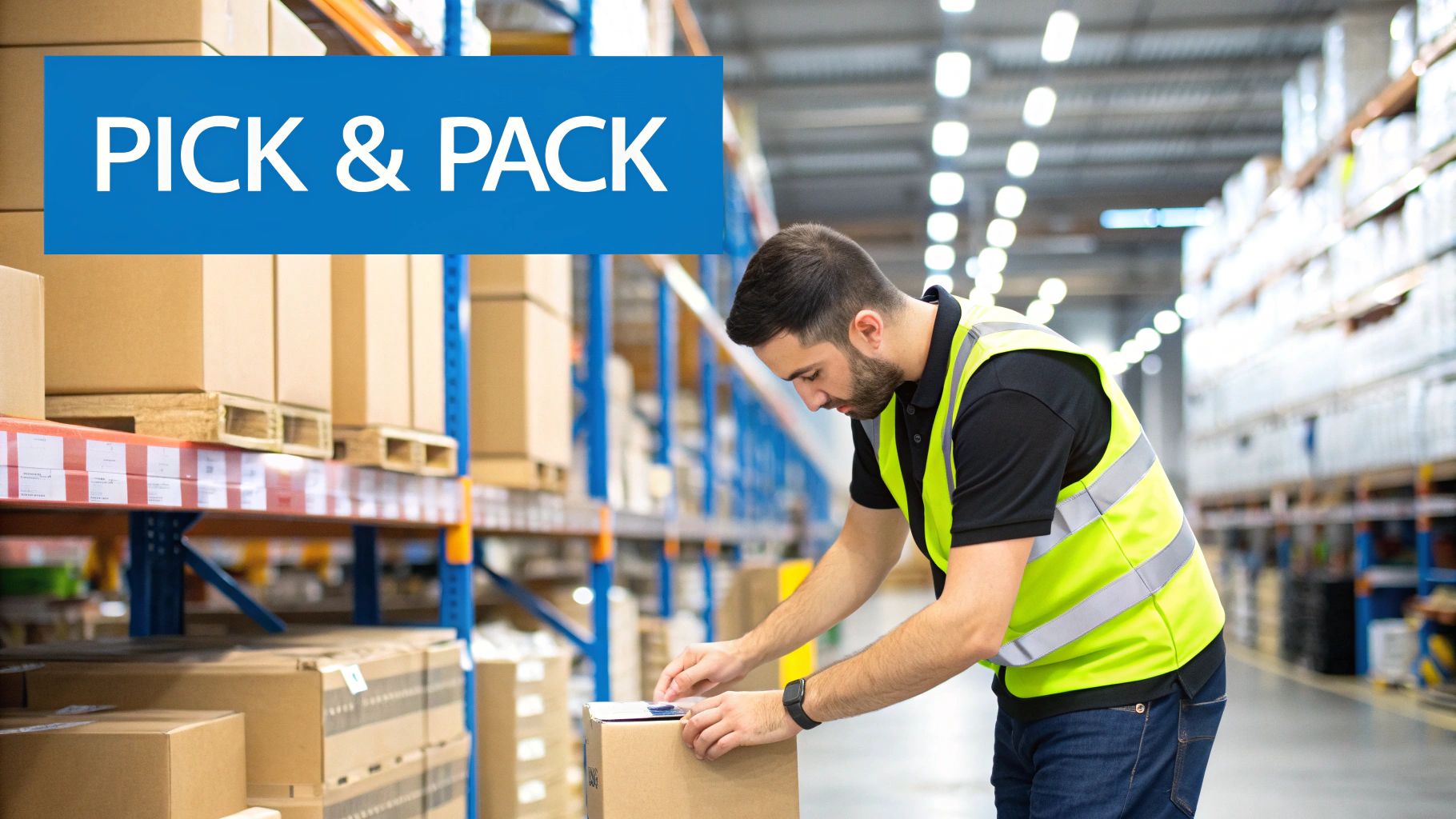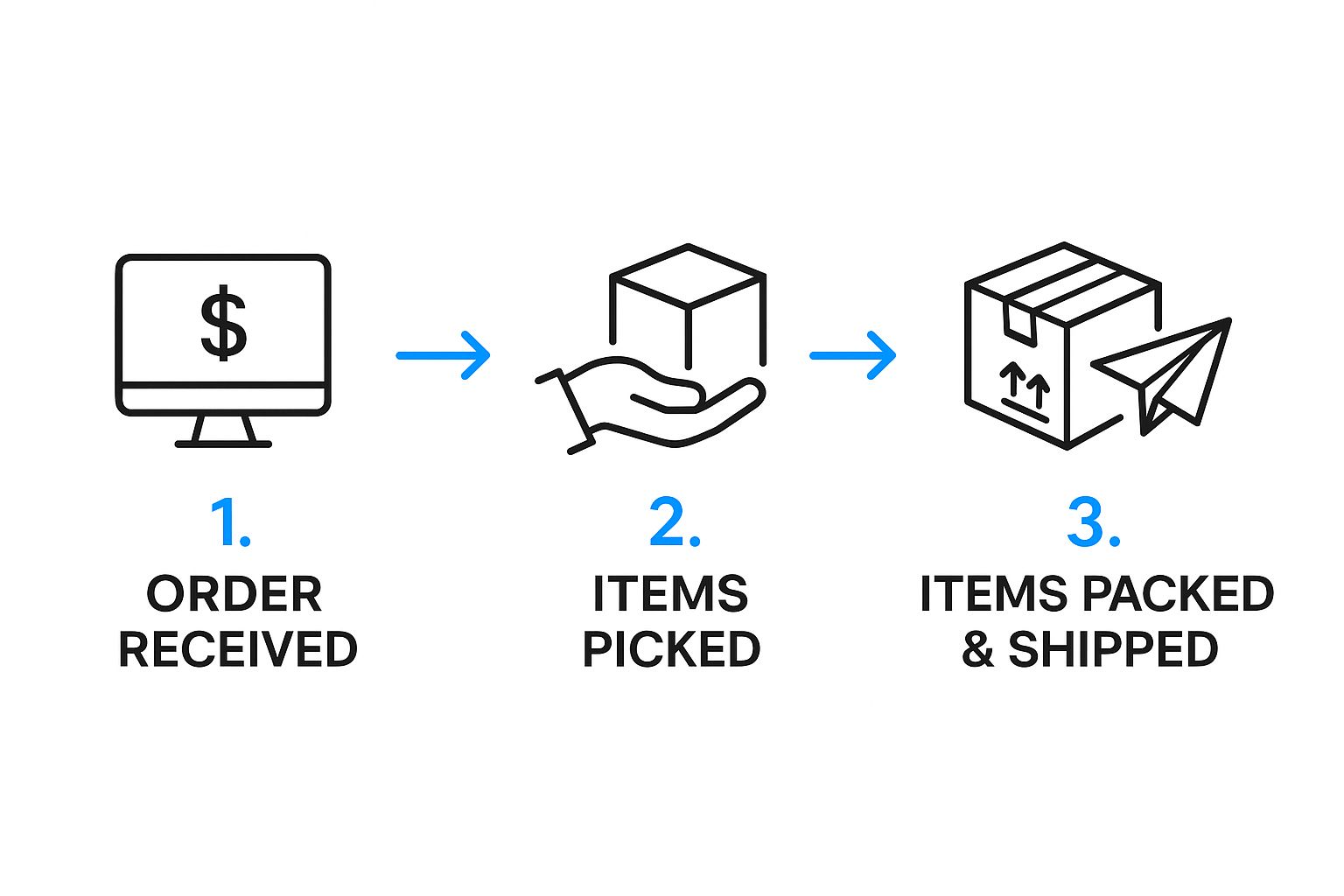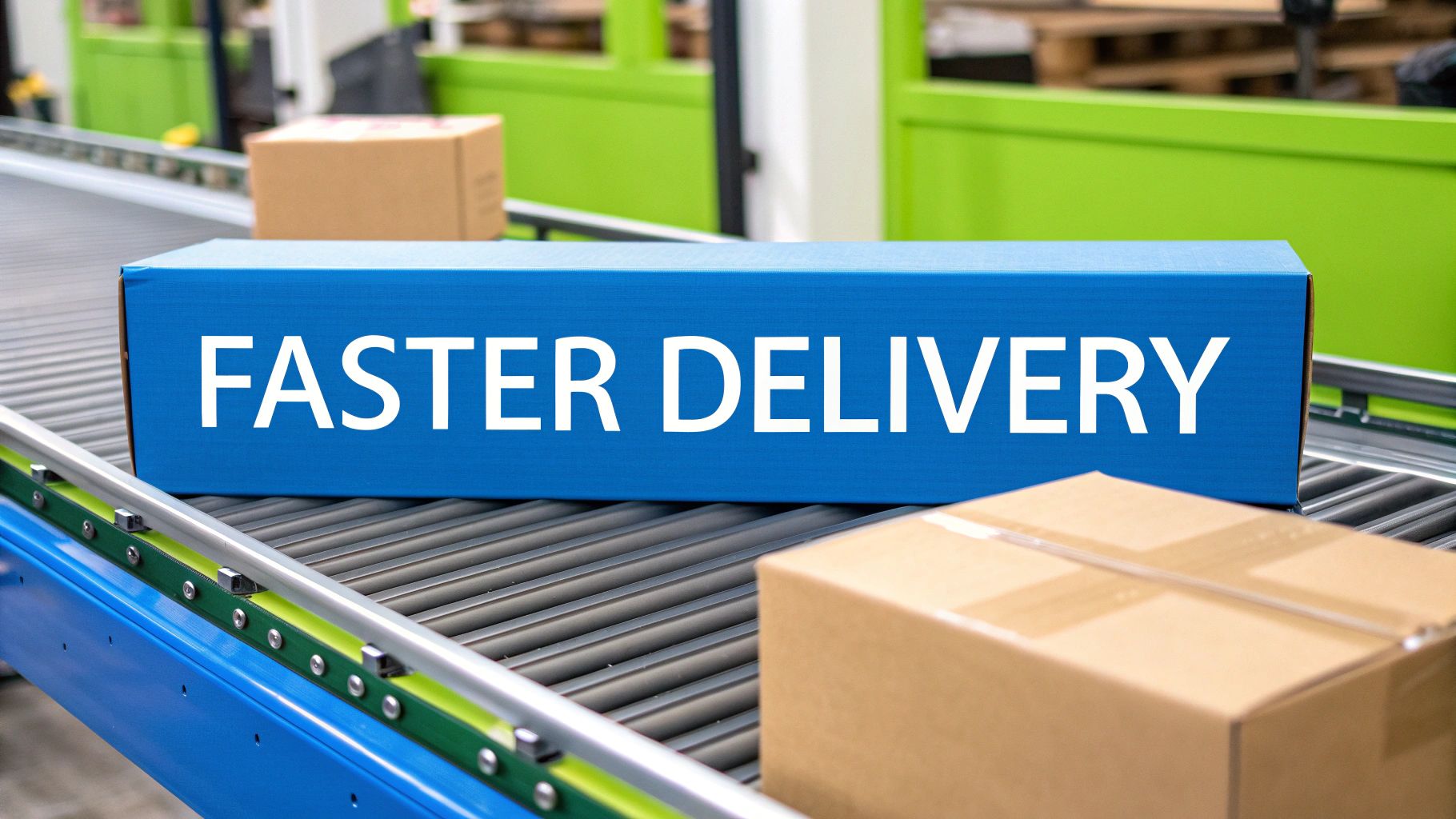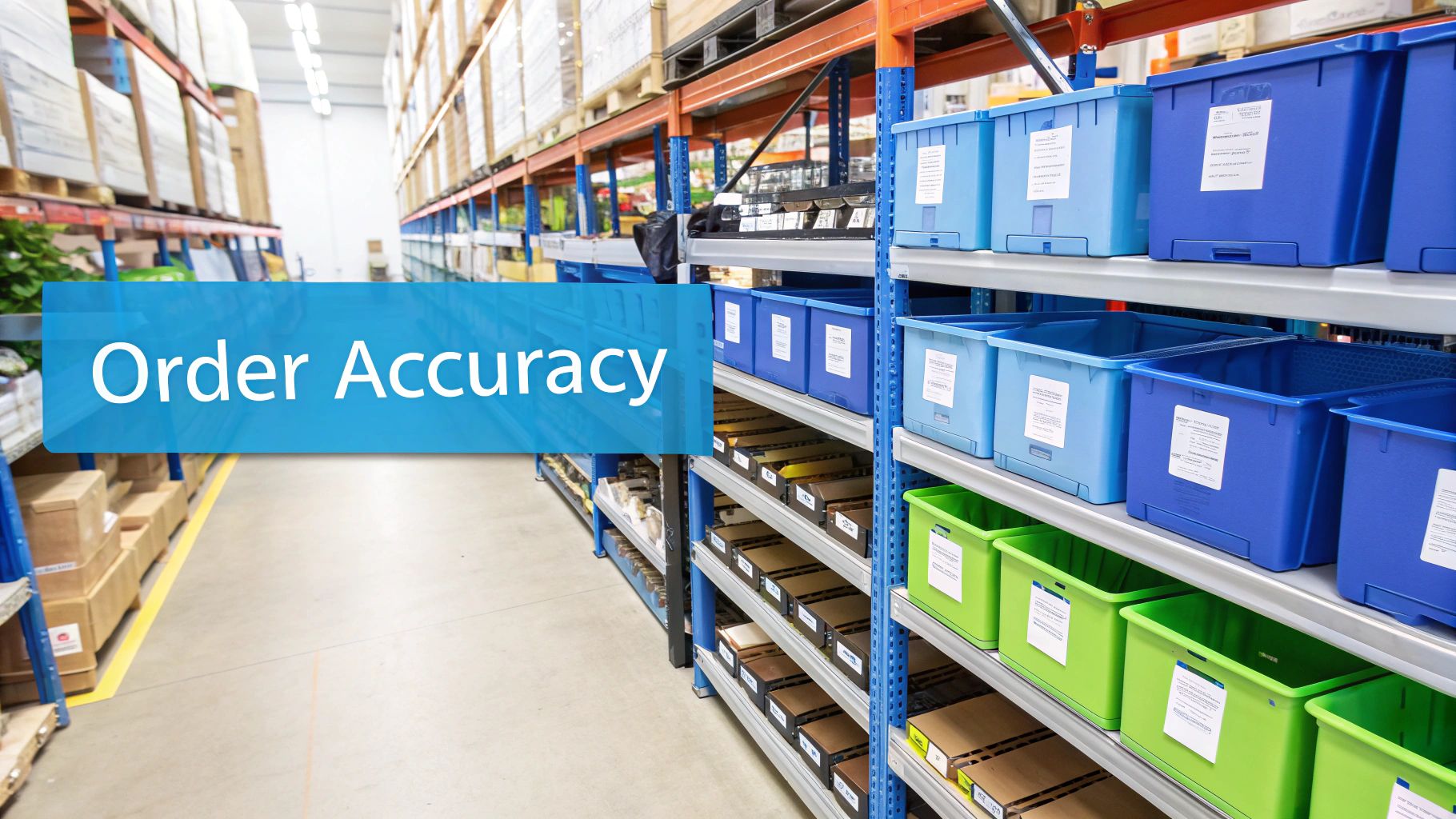Think of pick & pack fulfillment as the backstage crew for your eCommerce store. It’s the hands-on process that turns a customer's click into a physical package showing up on their doorstep. This is where the right items get selected, checked, and securely packaged for the journey ahead.
At its heart, pick & pack fulfillment is a two-step dance that forms the core of any warehouse operation. It's that critical moment when your digital inventory becomes a real, tangible order, ready to make a customer happy.
Imagine a highly efficient personal shopper who knows exactly where every single one of your products lives in a massive warehouse. When an order comes in, this "shopper" zips through the aisles to gather the correct products (the "pick"). Next, they bring everything to a packing station to be carefully inspected, protected with the right materials, and placed into a perfectly sized box (the "pack"). The whole workflow is built for speed and, most importantly, accuracy. A mistake here isn't just an inconvenience; it can be a costly error that damages your brand's reputation.
Getting this process right is a make-or-break moment for customer satisfaction. A smooth, efficient system delivers on several key promises:

Ultimately, the pick and pack process directly shapes how customers see your brand. A seamless, fast, and accurate delivery reinforces their decision to buy from you and encourages them to come back. On the flip side, a slow process filled with errors leads to negative reviews and lost customers.
This system is a foundational piece of the larger world of eCommerce fulfillment services, and mastering it is non-negotiable for growth.
The accuracy of your pick & pack fulfillment is a direct reflection of your brand's promise. Every correctly picked item and securely packed box builds trust, while every mistake erodes it.
To help you get a handle on how all the pieces fit together and why they matter, here’s a quick overview of what this process involves.
The table below breaks down the core components of the pick and pack process and shows how each one directly impacts your eCommerce business.
Think of these three components as the pillars supporting your entire fulfillment operation. Getting each one right is essential for building a scalable and customer-centric business.
The entire pick and pack fulfillment process is a well-oiled machine, engineered for speed and precision. From the second your inventory hits the warehouse dock to the moment it’s on a truck headed to your customer, every step is fine-tuned. Let's walk through the four key stages of this journey.
It all starts the moment a customer clicks "buy," kicking off a flurry of activity inside the fulfillment center. This infographic gives a great high-level view of how it all connects.

As you can see, once an order is placed, the "picking" and "packing" steps are the heart of the operation, preparing the package for its final trip. Each stage is a critical handoff that keeps the whole system running without a hitch.
Before a single order can be picked, your products have to be checked in and put away correctly. This is way more than just tossing boxes on a shelf; it's a strategic process that sets up the entire operation for success.
When a shipment arrives, warehouse staff inspect it for accuracy and damage, making sure the products and quantities match the manifest. Any issues are flagged immediately to keep inventory counts accurate from the get-go.
Once verified, every item gets assigned a specific home in the warehouse, usually managed by a Warehouse Management System (WMS). The WMS is smart about it, too. For instance, your best-selling items are often stored in the most accessible spots to cut down on the time it takes for pickers to grab them.
Key Takeaway: Solid receiving practices are the bedrock of good inventory management. One mistake here—like a miscount or putting an item in the wrong spot—will create a domino effect, leading to picking errors and stockouts down the road.
This is where the "pick" in pick and pack comes to life. As soon as a customer's order comes through, the WMS generates a picking list. Think of it as a treasure map for the warehouse worker, telling them exactly what to grab and where to find it.
There are a few different ways to go about this, depending on the business and how many orders are flowing through.
No matter the strategy, the goal is always the same: get the right items as quickly as possible. To see how these steps fit into the broader ecosystem, you can learn more about how eCommerce fulfillment works and see the entire process from A to Z.
Once all the items for an order have been picked, they’re sent to a packing station. This step is about more than just putting things in a box; it’s crucial for protecting your products and creating a great unboxing experience.
First, the packer does a final quality check, making sure the items are correct and in perfect condition.
Then, they choose the right packaging. This means finding a box that’s just the right size—not so big that items rattle around, but not so small they could get crushed. They’ll add filler like bubble wrap or air pillows to keep everything snug and secure. This is also where you can add a personal touch with branded boxes, custom tape, or marketing inserts like thank-you cards.
The final leg of the journey is getting the package ready for the carrier. The packed box is weighed and measured, and the WMS prints the perfect shipping label based on the customer’s chosen delivery option.
Accuracy here is everything. A wrong address or a poorly placed label can cause major delays or even a lost package, which nobody wants.
After being labeled, packages are sorted by carrier—USPS, FedEx, UPS—and staged for pickup. When the truck arrives, the packages get one last scan as they’re loaded, which is what triggers that all-important shipping confirmation email and tracking number for your customer. And just like that, the pick and pack cycle is complete.

It’s easy to look at fulfillment as just another line item on a spreadsheet—a necessary cost of doing business. But that view misses the bigger picture entirely. Mastering your pick & pack fulfillment isn't just about moving boxes from A to B; it's a direct and powerful investment in your brand's growth, customer loyalty, and long-term health.
Think of it this way: every single order that leaves your warehouse is a physical conversation with your customer. A fast, accurate, and seamless fulfillment process ensures that conversation is a great one. It reinforces their decision to choose you, turning a one-time buyer into a loyal advocate.
The impact of getting this right is massive. The global e-commerce fulfillment market is projected to hit $123.7 billion in 2025, which is a staggering 12.9% jump from the year before. This explosion shows just how critical fast, reliable delivery has become. It's also why around 60% of online retailers now outsource at least part of this crucial function. You can dig into more of the numbers with these eCommerce fulfillment statistics and trends.
The most immediate payoff from a fine-tuned pick & pack operation is accuracy. When customers consistently receive exactly what they ordered, you build a deep, foundational layer of trust. This is about more than just avoiding a bad review; it’s about eliminating the kind of friction that sends customers to your competitors for good.
Pinpoint accuracy also slashes the high cost of reverse logistics. Let's be honest, returns are a killer—they drain time, labor, and shipping fees. By getting the order right the first time, you protect your margins and keep customers happy.
When fulfillment is flawless, the customer's focus stays on the quality of your product, not the reliability of your service. This is how strong brands are built—one perfect order at a time.
This reliability is what fuels repeat business. A customer who trusts you to deliver correctly every time is far more likely to come back, which dramatically increases their lifetime value (LTV).
In today's market, speed isn't a luxury; it's a key differentiator. An efficient fulfillment system means faster processing times, which allows you to offer the competitive shipping options that modern consumers demand. When your warehouse can pick, pack, and ship an order in a matter of hours instead of days, you're not just meeting expectations—you're exceeding them.
This operational speed also leads directly to lower labor costs per order. That frees up capital you can then reinvest into other growth areas, like marketing or new product development.
Beyond that, a truly effective fulfillment strategy is built to scale. It’s designed to handle a massive Black Friday sale or an unexpected viral moment without crumbling under the pressure. A scalable pick & pack fulfillment process means your brand’s reputation for reliability holds strong even as your order volume skyrockets, allowing you to chase growth opportunities without hesitation.
Moving from a neat flowchart to the controlled chaos of a real warehouse floor is where the real work begins. Even the most carefully designed pick & pack fulfillment plan will run into friction. These operational hurdles aren't signs of failure; they're your best opportunities to sharpen your process, slash costs, and ultimately create a much happier customer.
The key to navigating these challenges is to meet them head-on with smart strategies and a solid grasp of the trade-offs. From managing inventory to laying out your shelves, every choice you make sends ripples through your entire operation, affecting both speed and accuracy.
One of the first big decisions you'll face is how to value and move your stock. This goes way beyond accounting—it directly dictates which products your team grabs off the shelf first. The two classic methods here are FIFO and LIFO.
Beyond your chosen method, you have to constantly fight against inventory shrinkage. This is the frustrating loss of products that happens somewhere between receiving and selling, often due to damage, theft, or simple clerical errors. Your best weapons in this fight are regular cycle counts and a reliable Warehouse Management System (WMS).
A high picking error rate is one of the sneakiest profit killers in fulfillment. A single mistake can easily cost you $22 or more when you factor in the labor for processing the return, restocking the item, and shipping a replacement—not to mention the damage to your brand's reputation.
Think of your warehouse layout like the street grid of a city. A poorly planned grid leads to traffic jams, long detours, and a ton of wasted time. The entire goal is to create the shortest, most efficient travel path for your pickers, especially since walking can eat up over 50% of their time on the clock.
A smart layout puts your best-sellers (your "A" items) in the most accessible spots, typically right near the packing stations. This one change can dramatically cut down on travel time and supercharge the number of orders a single person can pick in an hour. For a deeper look at solving these kinds of problems, check out our guide on overcoming the top 5 logistics challenges.
The specific method your team uses to collect items for an order is another make-or-break decision. There’s no single "best" way to do it; the right strategy is completely dependent on your order volume, the variety of products you sell, and your warehouse setup. Getting this right is fundamental to an efficient pick & pack fulfillment operation.
To help you figure out what makes the most sense for your business, here’s a breakdown of the most common order picking methods.
As you can see, the jump from piece picking to something more advanced like wave picking is huge. The best choice always comes back to your specific operational DNA—what works for a massive retailer won't work for a boutique brand, and that's perfectly okay. The goal is to pick the strategy that lets your team work smarter, not harder.

Manual processes can only get your pick & pack fulfillment operation so far. To hit the speed, accuracy, and scale you need to compete today, technology isn't a luxury—it's the engine that powers a modern warehouse. The right tools turn guesswork into data-driven precision, sharpening every step from inventory storage to the final shipment.
At the heart of this tech ecosystem is the Warehouse Management System (WMS). Think of a WMS as the central brain of your entire fulfillment operation. It tracks every single item, knows its exact location at all times, and guides your team along the most efficient paths to pull products for an order. This system is the foundation for nearly every other piece of tech in the building.
For businesses weighing their options, our comprehensive warehouse management software comparison guide offers a detailed breakdown of the top players on the market.
With a WMS acting as the command center, several key tools bring its intelligence to life on the warehouse floor. These technologies work in tandem to slash human error and dramatically boost the number of orders your team can process.
These tools are designed to empower your team, making their jobs easier, faster, and far more accurate.
While scanners and light systems are powerful, robotics and automation are the next frontier for creating a hyper-efficient warehouse. These systems take over the repetitive, physically demanding tasks, freeing up your team to focus on quality control and other more complex duties.
Automation is changing the game for pick & pack fulfillment. Despite the rise of these systems, over 50% of warehouse labor is still spent on manual picking and packing. But here's the kicker: merchants who fully embrace advanced warehouse technology can achieve a near-perfect 99.95% fulfillment accuracy rate. That number shows just how powerful automation is for cutting down errors and keeping customers happy.
A smart warehouse doesn't just move products faster; it generates valuable data with every scan and movement. This data is the key to identifying bottlenecks, forecasting demand, and continuously refining your entire fulfillment strategy for peak performance.
To really dial in the shipping part of your process and prevent costly mistakes, consider how solutions for automating shipping compliance can plug into your existing systems. These tools can automatically validate addresses and apply the correct shipping rules, saving both time and money. By integrating these systems, you create a seamless flow from the picking bin to the customer's doorstep, ensuring every package meets carrier requirements without any manual headaches.
The world of pick & pack fulfillment is always on the move, pushed forward by customers who want their orders faster and a growing demand for eco-friendly business practices. The strategies that feel cutting-edge today are really just the launching pad for what’s next. To stay competitive, you have to look at the trends that are fundamentally reshaping logistics right now.
Two massive forces are steering this evolution: the explosion of hyperlocal delivery and the non-negotiable importance of sustainability. These aren't just trendy topics; they represent a deep shift in how products get from a warehouse shelf to a customer's hands. For any eCommerce brand, getting a handle on these trends is crucial for building a business that lasts.
One of the biggest game-changers we're seeing is the pop-up of hyperlocal fulfillment centers, especially in packed urban areas. These small-scale hubs—often tucked into repurposed retail stores or small city warehouses—are letting brands slash delivery times by storing inventory just a few miles from their customers.
This is a direct answer to the demand for same-day, or even one-hour, delivery. Instead of shipping everything from a few giant, far-off warehouses, brands are building networks of smaller, strategically placed facilities. This closes that final, expensive "last-mile" gap. If you want to dig deeper, you can get more fulfillment trend insights and see how other businesses are getting it done.
By decentralizing inventory and moving it closer to population centers, brands can turn a two-day delivery promise into a two-hour reality. That's a massive competitive edge in a crowded market.
Speed isn't the only thing that matters anymore. Today’s shoppers are increasingly voting with their wallets, choosing brands that show a real commitment to the environment. This has rocketed sustainable practices to the top of the priority list for pick & pack fulfillment, making green choices a business necessity.
This shift toward eco-friendly logistics touches every single step of the process:
Getting ahead of these shifts in customer expectations and logistics technology is what gives you the foresight to keep your business ahead of the curve.
Even after getting the hang of the pick and pack process, some practical questions always seem to pop up when you're thinking about changing your fulfillment strategy. Let's tackle the most common ones that business owners ask. My goal here is to give you direct answers so you can make confident, smart decisions for your brand.
Fulfillment costs aren't just one single number; they're a mix of several different charges. Getting a handle on this breakdown is the key to managing your expenses. Typically, a third-party logistics (3PL) partner will bill for a few separate activities.
When you add all these up, you get your total fulfillment cost for each order.
Key Insight: Don't get fixated on just the per-pick fee. A 3PL might advertise a super low pick fee but make up for it with high storage or receiving costs. Always look at the total cost to get the real picture.
Knowing when to hand off your fulfillment is a huge decision. Most brands start out packing boxes in a garage or office, but there are some pretty clear signs it's time to bring in a pro.
It’s probably time to look for a 3PL when:
While pick and pack gives you incredible control over your inventory and the customer experience, it's not the only game in town. Some businesses, especially those just starting out, might choose an alternative like dropshipping.
With dropshipping, a third party holds the inventory and ships orders directly to your customers for you. The landscape of eCommerce is full of different strategies, including those that use tools like Shopify apps for dropshipping, and it's smart to understand where pick and pack fits in. Each model offers unique advantages depending on your product, your business goals, and how much you've grown.
Ready to stop packing boxes and start scaling your brand? Simpl Fulfillment offers a reliable, transparent, and tech-forward approach to pick & pack fulfillment, designed to help your eCommerce business thrive. Get your free quote today!